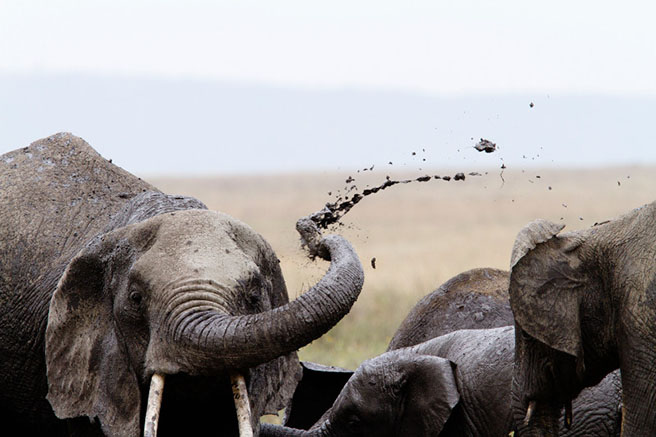Elephants are Artists

The Ancient Greek philosopher, Aristotle, once said that elephants were "the animal which surpasses all others in wit and mind."
Elephants exhibit a wide variety of behaviors, including those associated with grief, learning, mothering, mimicry, play, altruism, use of tools, compassion, cooperation, self-awareness, memory, and language.
Like several other species that are able to produce abstract art, elephants using their trunks to hold brushes to create paintings, which some have compared to the work of abstract expressionists. This was the case with Ruby (1973 – November 6, 1998) a 4.5-ton Asian elephant that lived at the Phoenix Zoo and was famous for creating paintings. The most expensive of her paintings sold for $25,000. When the Phoenix Zoo announced a free-admission day in honor of Ruby's memory, 43,000 people attended.
There are a great many painting elephants all over the world today. Then there is the movie star Tai. She played the major role of Vera in the 1996 comedy “Larger than Life” alongside Bill Murray, and had a minor role in George of the Jungle in 1997, where she can be seen being ridden by Brendan Fraser and Leslie Mann. Tai's performances in Vanity Fair in 2004 and “Water for
Elephants” in 2011 were praised. One of Tai's paintings as well as an autographed poster for Water for Elephants was auctioned off on eBay to raise awareness of elephant endotheliotropic herpesvirus (EEHV). The money Tai raised from the auction was given to the International Elephant Foundation, which distributed it to the appropriate labs and research facilities actively working to find a cure for EEHV.
They can also mimic sounds they hear, including human language. “It is of interest to note that while some dolphins (in this case elephants) are reported to have learned English - up to fifty words used in correct context - no human being has been reported to have learned dolphinese.” -Carl Sagan
Batyr (July 23, 1969 – August 26, 1993), an Asian elephant, is claimed to be able to use a large amount of meaningful human speech. Kosik a male Indian elephant in the Everland theme park in Yongin, South Korea, made headlines in September 2006, when it was discovered he could imitate the Korean words for "yes," "no," "sit," "lie down," and a few other words. He makes the sounds by putting his trunk in his mouth and shaking it while exhaling, similar to the way a human whistles with fingers in his or her mouth. The fact that Koshik talks pales compared with how he talks. When humans make an o sound, they pull in their cheeks and pout their lips out into a rounded circle. Elephants don't have that cheek-lip structure—they long ago traded it in for trunks—so it's anatomically impossible to make those sounds. Koshik sidesteps this problem by sticking the tip of his trunk into his mouth and moving his lower jaw, essentially MacGyvering his vocal tract. He really developed a new way of sound production, Angela S. Stoeger said. Naturally, Asian elephants don't do this.
As entertaining and remarkable as these displays of intelligence are—and despite he positive impact they may be having on our social awareness regarding the incredible attributes of elephants and their likeness to us—this majestic species does not deserve to be used for the amusement of humans.
Fight for the protection and preservation of elephants by donating today so that they may have protected land to roam free, so that their only means of survival is not in captivity.
